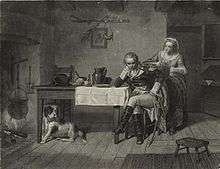Elizabeth Maxwell Steele
| Elizabeth Maxwell Steele | |
|---|---|
 | |
| Born |
1733 Salisbury, Rowan County, North Carolina, United States |
| Died |
November 22, 1790 Salisbury, Rowan County, North Carolina, United States |
Elizabeth Maxwell Steele (c. 1733-1790) was an active supporter of the American Revolution. She helped run a prominent tavern in Salisbury, North Carolina that served as a “resort” for many notable figures of the time. Her involvement with the tavern allowed her to support the Revolution by offering hospitality and charity to other supporters of the American cause.
Early life and family
Steele was born in 1733 to a Scottish family, who had previously immigrated to Pennsylvania and later settled in Rowan County, North Carolina. Steele's ancestors, the Maxwells, had a long lineage in Scotland and held numerous titles and awards. The Maxwell family originally earned its high status in Scotland about 600 years ago, when Sir Eustace Maxwell fought with Sir William Wallace in in the Wars of Scottish Independance.[1]
Steele first married Robert Gillespie, and had two children with him, Robert Jr. and Margaret Gillespie.[1] Not much is known about Robert Gillespie Jr., and all that is known about Margaret Gillespie is that she married Samuel Eusebius McCorkle, who was a Presbyterian preacher and teacher.[2] Robert Gillespie Sr. died in 1760, after being scalped by Cherokee Native Americans during a siege of Fort Dobbs.[2]
After Robert Gillespie’s death, Steele Married her second husband William Steele, who was from Pennsylvania. They had one son together, John Steele. William Steele died before the Revolutionary War, which left Elizabeth Steele to raise three kids and run an ordinary tavern in Salisbury by herself. Steele also became involved in real estate speculation and was able to procure a small estate for herself.[2]
John Steele, Elizabeth Steele's only child by her second husband William Steele (a merchant, innkeeper, and local real estate speculator), went on to become appointed comptroller of the U.S. Treasury by President Washington. He also played a major role in defending the militia concept and criticizing a standing army accompanied by excessive executive authority.[3] There is also a book written about him called the Papers of John Steele.[4]
Participation in the American Revolutionary War
Elizabeth Steele, who was a Whig Patriot, is most renowned for aiding General Nathanael Greene on the morning of February 2, 1781 from her tavern in Cowan’s Ford in Mecklenburg County, North Carolina.
The encounter occurred at breakfast when a rather weary and disheartened General Nathanael Greene entered the tavern. He had been riding all night and had just learned of the death of General William Davidson at the hands of the British Lieutenant Colonel Banastre of the Tarleton’s Dragoons. Davidson was killed in an ambush that also claimed the lives of 15-50 of his men. This was a blow to the war effort and put Greene in a difficult tactical situation as he had been waiting the entire night for those men to launch a counter attack on the British.[5]
It quickly became clear to Steele that Greene was in need of aid. She gave him breakfast to help bolster his spirits. Once Steele learned of his current situation, she went into the backroom of her tavern and, upon her return, drew from under her apron two small bags full of specie, probably the earnings of a number of years. General Greene accepted with thankfulness.
After Greene’s encounter with Steele, his circumstances improved greatly. While still in Salisbury, he garnered Mrs. Steele’s aid, and he discovered a collection of more than 1,700 Continental arms that were stashed away for the militia. They were then put to use in resupplying the war against the British.[5]
Legacy
Steele's helping of Greene proved to be immensely important to improving his spirits and moral, which would soon translate into success on the battlefield in skirmishes in the coming days and months, notably at the Battle of Guilford Courthouse in mid March. General Greene's biographer noted of his encounter with Steele: "Never, did relief come at a more propitious moment; nor would it be straining conjecture to suppose that he resumed his journey with his spirits cheered and lightened by this touching proof of woman's devotion to the cause of her country."[5]
References
- 1 2 Makers of America;biographies of leading men of thought and action, the men who constitute the bone and sinew of American prosperity and life. Washington, D. C.,. 1915-01-01.
- 1 2 3 Steele, John; Steele, William Stevens (1979-12-01). Dictionary of North Carolina Biography. Univ of North Carolina Press. ISBN 9780807813294.
- ↑ Steele, John. "Biography of John Steele". NCPedia.
- ↑ Steele, John; Wagstaff, Henry McGilbert; North Carolina Historical Commission (1924-01-01). The papers of John Steele. Raleigh, [N.C.] : Edwards & Broughton.
- 1 2 3 Greene, Nathanael. "Nathanael Greene finds fortification at Steeles Tavern". www.history.com.